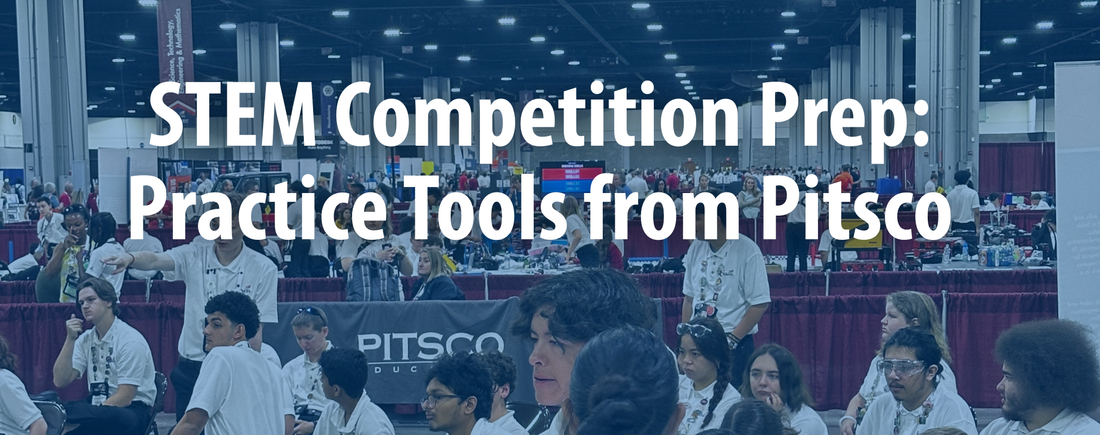The STEM competition space is more than your typical high-stakes fun. 86% of FIRST® alumnae go on to declare majors in STEM by their second year in college, despite many female competitors participating without much prior robotics experience. For many women in STEM, a single hands-on experience can lead to a lifetime love of science and more—and helps them defy statistics. No matter the student’s background, having a successful competition experience means practicing with the right tools—even for seasoned competitors; and Pitsco knows the perfect ones.

If You Can Build It, You Can Do It
In the competition space, practice makes perfect—or, it makes something more exciting, like a flyable drone or programmable robot. The truth is, having eyes on the prize (grand ones too: think scholarships and more) means hands-on practice that allows for lots of iteration. Because the best way to build a winning model in any competition is to build something right, then find a way to build it better. And competition time is NOT the moment to discover your prize-winning design fails to perform.
If creativity is your strong suit and innovation gets your heart pumping, consider the EZ Start Dragster Getting Started Package. This kit is essential for a team prepping for the TSA Dragster Design competition, as it leaves plenty of room to carve vehicle bodies from imaginations, then test them over and over again. With enough materials to build 50 dragsters, there’s no pressure to commit to your team’s first idea. Select the kit’s blanks from three TSA-approved options—basswood, balsawood, or fusion—then get your CO2-powered dragster track ready with all the equipment needed to race and refine your model.

Hard-Wiring Teamwork
When most people get mentally prepared for competition day, their main focus is engineering. The competitor’s mindset is one filled to the brim with images of wheels, gears, wires, and designs built with mathematical precision. What some forgot is a participant-favorite component: teamwork.
“It’s like a sisterhood,” a FIRST® Tech Challenge alumna beams.
Competition spaces focus on team-based challenges that bring students together—sometimes through adrenaline, sometimes through passion, and sometimes through trying something new together. On the field and during practice, collaboration is unavoidable, and learning to communicate effectively is the difference between a group that celebrates a victory and one that freezes up.
With Echo Drones and the Drone Industry Field Elements Kit, students can simulate real cooperative challenges from the SkillsUSA Commercial sUAS (Drone) Competition. Using an obstacle course with landing pads at various accessibility levels, students can immerse themselves in a mock competition environment while putting their teamwork to the test. One of the hardest competition tasks is a soft-skills challenge, where one team member has to pilot a drone to complete missions in an obstacle course—without viewing the course at all. Relying on only a small screen and the directions of the “spotter” teammate, the pilot must yaw, pitch, and roll the drone to perform the tasks successfully. It’s a true test of communication, where clear instructions and active listening stand between teammates and a high score. But with the Echo Drone and Drone Industry Field Elements Kit, those hard-to-see obstacles and hidden skill tests are easy to master.

Action Makes Perfect
Sometimes to learn it, you have to do it. No matter how many hours students spend watching videos on tips and tricks, they don’t compare to hands-on experiences that can give competitors context for all the variables they might encounter.
Especially in competitions like the FIRST® Tech Challenge, which require both building and programming skills, evaluating the operation of and troubleshooting builds is imperative to practice. The Tetrix® FIRST® Tech Challenge Competition Set is a kit that anticipates problem solving as a key part of the competition, and comes with 824 building elements, motor cables, and a hub conversion expansion pack so teams can experiment with mechanics and create a robot that is both a sophisticated model as well as a practical one. Because in these competitions, students don’t build to impress—they build to compete, ensuring their robots are mobile and can complete delivery challenges as efficiently as possible.
And while many competitors are thinking about field performance, others know their competitions require participants to put their knowledge to the test—literally. In the SkillsUSA Commercial sUAS (Drone) Competition, for example, students are scored on an assessment component that tests their ability to identify mistakes in builds, explain how features of their drones function, and demonstrate fluency in flight vocabulary. If students have used kits like Drone Infinity, they’ve not only practiced designing copter configurations and assembling their drones, but they also have plenty of experience exploring flight mechanics, troubleshooting, and industry knowledge through the kit’s curriculum. So, when it comes time to show what they know, participants are confident and ready to go.
With Pitsco, You’re In It To Win It
When Pitsco’s hands-on resources are part of competition prep, participants are able to take their jitters in stride. With equipment that immerses students in realistic competition environments, projects that promote collaboration, and parts that pose endless possibilities for design and iteration, students are more than prepared—they’re ready to win.
Discover the tools that take your team to the next level.

